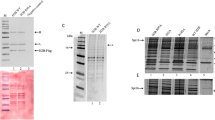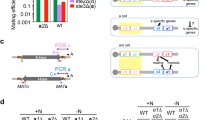Summary
MATa cells of Saccharomyces cerevisiae defective in both the SST1 and SST2 gene products exhibit selfarrest when they express the MFα1 gene under the control of the GAL1 promoter. This reponse to endogenously produced pheromone can be alleviated by mutations which prevent the production of, or response to, α-factor. Suppressors of the self-arrest phenotype include a class of mutants which remain responsive to low levels of pheromone, but are resistant to high levels of α-factor. One of these mutants has been mapped to chromosome X, 31 cM distal to SUP4, and defines a new locus designated STE18.
Similar content being viewed by others
References
Ammerer G, Sprague Jr GF, Bender A (1985) Control of yeast α-specific genes: Evidence for two blocks to expression in MATa/MATα diploids. Proc Natl Acad Sci USA 82:5855–5859
Bender A, Sprague GF Jr (1987) MATα1 protein, a yeast transcription activator, binds synergistically with a second protein to a set of cell-type-specific genes. Cell 50:681–691
Boeke JD, LaCroute F, Fink GR (1984) A positive selection for mutants lacking orotidine-5′-phosphate decarboxylase activity in yeast: 5-fluoro-orotic acid resistance. Mol Gen Genet 197:345–346
Bussey H, Meaden P (1985) Selection and stability of yeast transformants expressing cDNA of a M1 killer toxin-immunity gene. Curr Genet 9:285–291
Chan R, Otte CA (1982a) Isolation and genetic analysis of Saccharomyces cerevisiae mutants supersensitive to G1 arrest by a factor and α factor pheromones. Mol Cell Biol 2:11–20
Chan R, Otte CA (1982b) Physiological characterization of Saccharomyces cerevisiae mutants supersensitive to G1 arrest by a factor and α factor pheromones. Mol Cell Biol 2:21–29
Dietzel C, Kurjan J (1987) Pheromonal regulation and sequence of the Saccharomyces cerevisiae SST2 gene: a model for desensitization to pheromone. Mol Cell Biol 7:4169–4177
Hartwell L (1980) Mutants of Saccharomyces cerevisiae unresponsive to cell division control by polypeptide mating hormones. J Cell Biol 85:811–822
Ito H, Fukada Y, Murata K, Kimura A (1983) Transformation of intact Saccharomyces cerevisiae cells with alkali cations. J Bacteriol 153:163–168
Julius D, Brake A, Blair L, Kunisawa R, Thorner J (1984) Isolation of the putative structural gene for the lysine-arginine-cleaving endopeptidase required for processing of yeast prepro-α-factor. Cell 37:1075–1089
Manney T (1983) Expression of the BAR1 gene in Saccharomyces cerevisiae: Induction by the α mating pheromone of an activity associated with a secreted protein. J Bacteriol 155:291–301
Moore SA (1984) Yeast cells recover from mating pheromone α factor-induced division arrest by desensitization in the absence of α factor destruction. J Biol Chem 259:1004–1010
Mortimer RK, Schild D (1985) Genetic map of Saccharomyces cerevisiae, edition 9. Microbiol Rev 49:181–213
Nakayama N, Miyajima A, Arai K (1987) Common signal transduction system shared by STE2 and STE3 in haploid cells of Saccharomyces cerevisiae: autocrine cell-cycle arrest results from forced expression of STE2. EMBO J 6:249–254
Novick P, Field C, Schekman R (1980) Identification of 23 complementation groups required for post-translational events in the yeast secretory pathway Cell 21:205–215
Rothstein RJ (1983) One-step gene replacement in yeast. Methods Enzymol 101:202–211
Sherman F, Fink GR, Hicks JB (1982) Methods in yeast genetics. Cold Spring Harbor Laboratory, Cold Spring Harbor, NY
Sprague GF Jr, Blair LC, Thorner J (1983) Cell interactions and regulation of cell type in the yeast Saccharomyces cerevisiae. Annu Rev Microbiol 37:623–660
Strathern JN, Hicks JB, Herskwitz I (1981) Control of cell type by the mating type locus: The α1–α2 hypothesis. J Mol Biol 147:357–372
Van Arsdell SW, Stetler GL, Thorner J (1987) The yeast repeated element sigma contains a hormone-inducible promoter. Mol Cell Biol 7:749–759
Whiteway MS, Szostak JW (1985) The ARD1 gene of yeast functions in the switch between the mitotic cell cycle and alternative developmental pathway. Cell 43:483–492
Author information
Authors and Affiliations
Additional information
Communicated by C.P. Hollenberg
Rights and permissions
About this article
Cite this article
Whiteway, M., Hougan, L. & Thomas, D.Y. Expression of MFα1 in MATa cells supersensitive to α-factor leads to self-arrest. Mol Gen Genet 214, 85–88 (1988). https://doi.org/10.1007/BF00340184
Received:
Issue Date:
DOI: https://doi.org/10.1007/BF00340184




